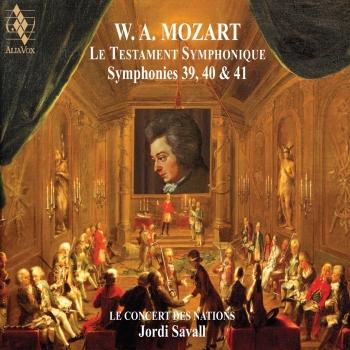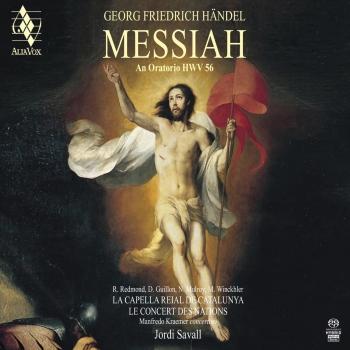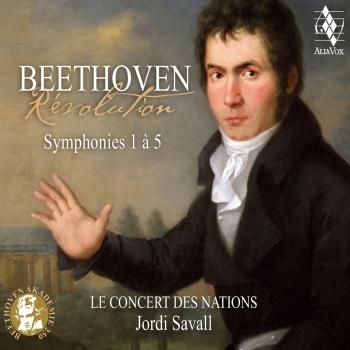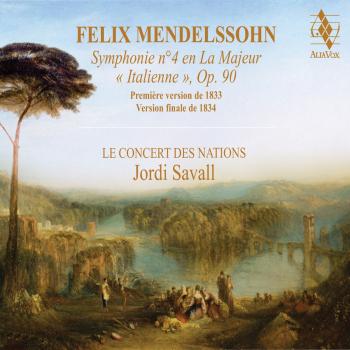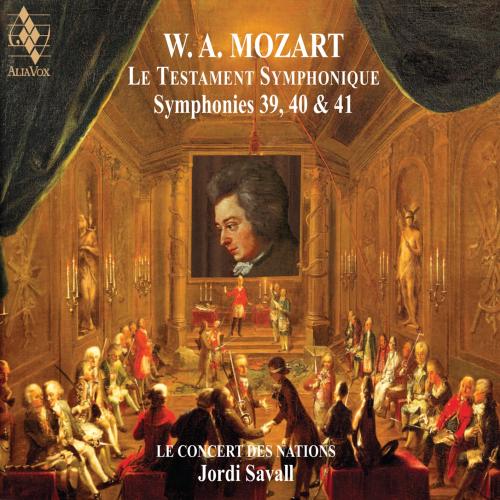
Mozart: Le Testament Symphonique Jordi Savall & Le Concert des Nations
Album info
Album-Release:
2019
HRA-Release:
31.05.2019
Label: Alia Vox
Genre: Classical
Subgenre: Chamber Music
Artist: Jordi Savall & Le Concert des Nations
Composer: Wolfgang Amadeus Mozart (1756-1791)
Album including Album cover
- Wolfgang Amadeus Mozart (1756 - 1791): Symphony No. 39 in E-Flat Major, K. 543:
- 1 Symphony No. 39 in E-Flat Major, K. 543: I. Adagio – Allegro 10:44
- 2 Symphony No. 39 in E-Flat Major, K. 543: II. Andante con moto 07:26
- 3 Symphony No. 39 in E-Flat Major, K. 543: III. Menuetto : Allegretto - Trio 04:00
- 4 Symphony No. 39 in E-Flat Major, K. 543: IV. Allegro 08:45
- Symphony No. 40 in G Minor, K. 550:
- 5 Symphony No. 40 in G Minor, K. 550: I. Molto allegro 07:19
- 6 Symphony No. 40 in G Minor, K. 550: II. Andante 14:07
- 7 Symphony No. 40 in G Minor, K. 550: III. Menuetto : Allegretto - Trio 04:24
- 8 Symphony No. 40 in G Minor, K. 550: IV. Allegro assai 09:49
- Symphony No. 41 in C Major, K. 551 "Jupiter":
- 9 Symphony No. 41 in C Major, K. 551 "Jupiter": I. Allegro vivace 12:19
- 10 Symphony No. 41 in C Major, K. 551 "Jupiter": II. Andante cantabile 09:59
- 11 Symphony No. 41 in C Major, K. 551 "Jupiter": III. Menuetto : Allegretto - Trio 05:05
- 12 Symphony No. 41 in C Major, K. 551 "Jupiter": IV. Molto allegro 12:37
- Maurerische Trauermusik, K. 477:
- 13 Maurerische Trauermusik, K. 477 05:20
Info for Mozart: Le Testament Symphonique
Wolfgang Amadeus Mozart - The Symphonic Testament: Following a long maturation process, Jordi Savall presents his interpretation of Mozart’s Last Three Symphonies.
He has chosen - on this double album - to repeat the Symphony No. 40 twice, in order to underline the continuity existing from one work to the other (this is an important dimension of this milestone of the orchestral music in the XVIIIth Century).
The Concert des Nations is at its best and put flesh and bone on this vision, in which fluidity and theatricalness dominate.
By the middle of 1788, at the age of 32, Mozart had reached the height of his creative maturity, dominated by the last three symphonies, absolute masterpieces that he composed in a very short period of time – barely one and a half months. This extraordinary “symphonic massif” consisting of three peaks – Symphony No. 39 in E-flat major, completed on 26th June, Symphony No 40 in G minor, completed on 25th July and Symphony No. 41 in C major, the “Jupiter”, dated 10th August – is unquestionably the composer’s “Symphonic Testament”.
Le Concert des Nations
Jordi Savall, conductor
Le Concert des Nations
Music is inevitably influenced by the personal circumstances of the person who composed it and by the social and cultural background at the time of its composition. The historical facts of each period, the composers, the instruments, the original intentions and motivations behind each score, comprise the palette for the player of ancient music, the imaginary backdrop for each new project.
Le Concert des Nations orchestra was founded by Jordi Savall and Montserrat Figueras in 1989 during preparations for the Canticum Beatae Virgine by M.A. Charpentier in order to create an orchestra with period instruments capable of performing a repertoire that would encompass the Baroque to Romanticism (1600-1850). Its name is derived from the work of François Couperin, Les Nations, a concept that represents the meeting of musical tastes and the feeling that Art, in Europe, would always have its own mark, that of the Age of Enlightenment. Directed from the outset by Jordi Savall, Le Concert des Nations was the first orchestra made up from a majority of musicians from Latin countries (Spain, Latin America, France, Italy, Portugal, etc.), all of them being distinguished world specialists in the performance of ancient music on original period instruments and using historical criteria.
Right from the beginning Le Concert des Nations aimed to raise awareness about a historical repertoire of great quality through performances that rigorously respected the original spirit of each work, but performed with a revitalising impulse. Good examples of this are the first recordings of Charpentier, J. S. Bach, Haydn, Mozart, Handel, Marais, Arriaga, Beethoven, Purcell, Dumanoir… and more recently the recordings made under the Alia Vox label of Lully, Biber, J.S. Bach, Boccherini, Rameau and Vivaldi.
The impact of the works and composers chosen, the recordings made and their performances throughout the main cities and music festivals around the world have earned the orchestra a reputation as one of the best orchestras playing period instruments and one that is capable of engaging with an eclectic and varied repertoire that includes the first music written for orchestra (the orchestra of Louis XIII, 1600-1650) up to the masterpieces of Romanticism and Classicism.
In 1992 Le Concert des Nations made its operatic debut with Una Cosa Rara by Martín i Soler and went on to continue its operatic work with Monteverdi’s L’Orfeo, performed for the first time in 1993 and again in 1999, 2001, and 2002 at the Gran Teatre del Liceu in Barcelona, the Gran Teatro Real in Madrid, in Beaune, Vienna and Metz. In 1995 another opera by Martín i Soler was performed in Montpellier, Il Burbero di Buon Cuore and in 2000 Celos aun del Ayre matan by Juan Hidalgo and Calderón de la Barca was performed in a concert version in Barcelona and Vienna. Other notable opera productions are Vivaldi’sFarnace, premièred at the Teatro de la Zarzuela in Madrid (2001) and published on CD, and Monteverdi’s L’Orfeo, which was finally recorded on DVD by the BBC/Opus Arte (2002), as was The Seven Last Words of Our Saviour on the Cross by F. J. Haydn in a co-production between Element Productions and Alia Vox (2007).
This album contains no booklet.










